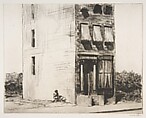The Lonely House
Edward Hopper American
Not on view
Hopper uses a building to convey emotion by placing two girls playing next to the largely blank wall of a house whose placement evokes missing neighbors. The artist had returned to New York from Paris in 1910 and took up etching when his paintings failed to find buyers, producing about 70 prints between 1915 and 1923. In addition to depicting men and women experiencing the urban fabric of New York, he recalled scenes in France and explored rural and coastal landscapes in Maine and Massachusetts. After Hopper received two awards for his prints in 1923—the Logan Prize from the Chicago Society of Etchers and the W. A. Bryan Prize—he refocused his energies on painting, but often returned to subjects he had used etching to shape.
Due to rights restrictions, this image cannot be enlarged, viewed at full screen, or downloaded.


